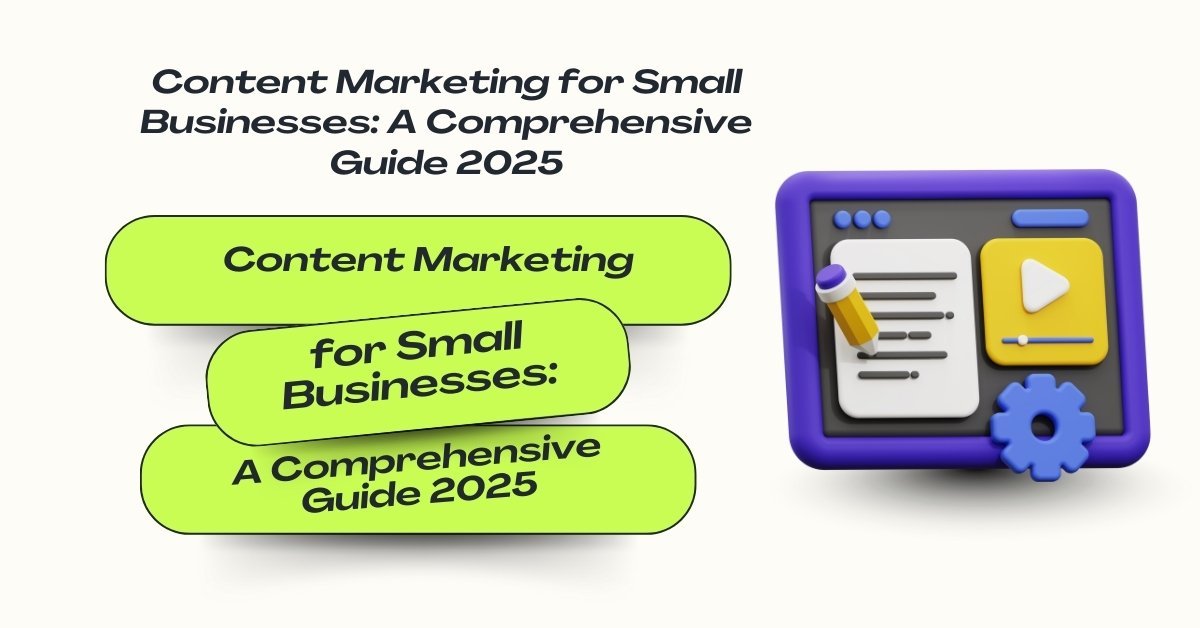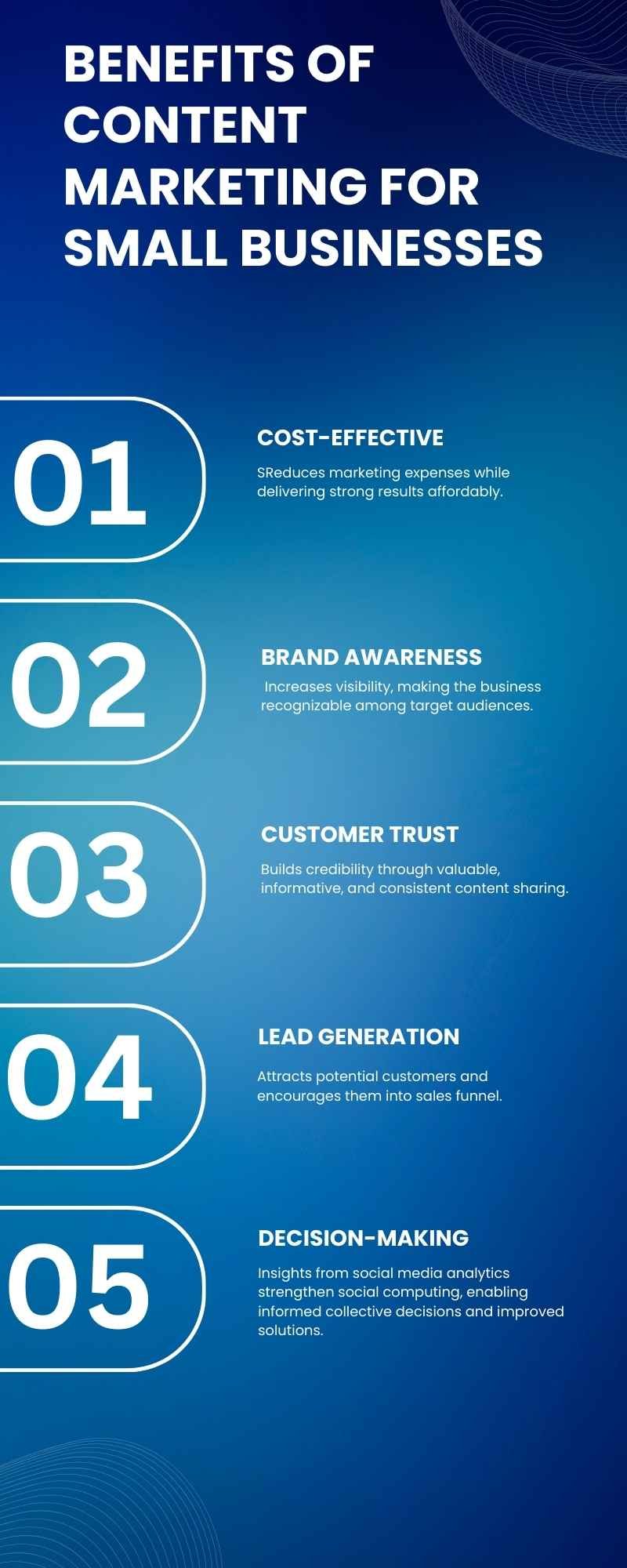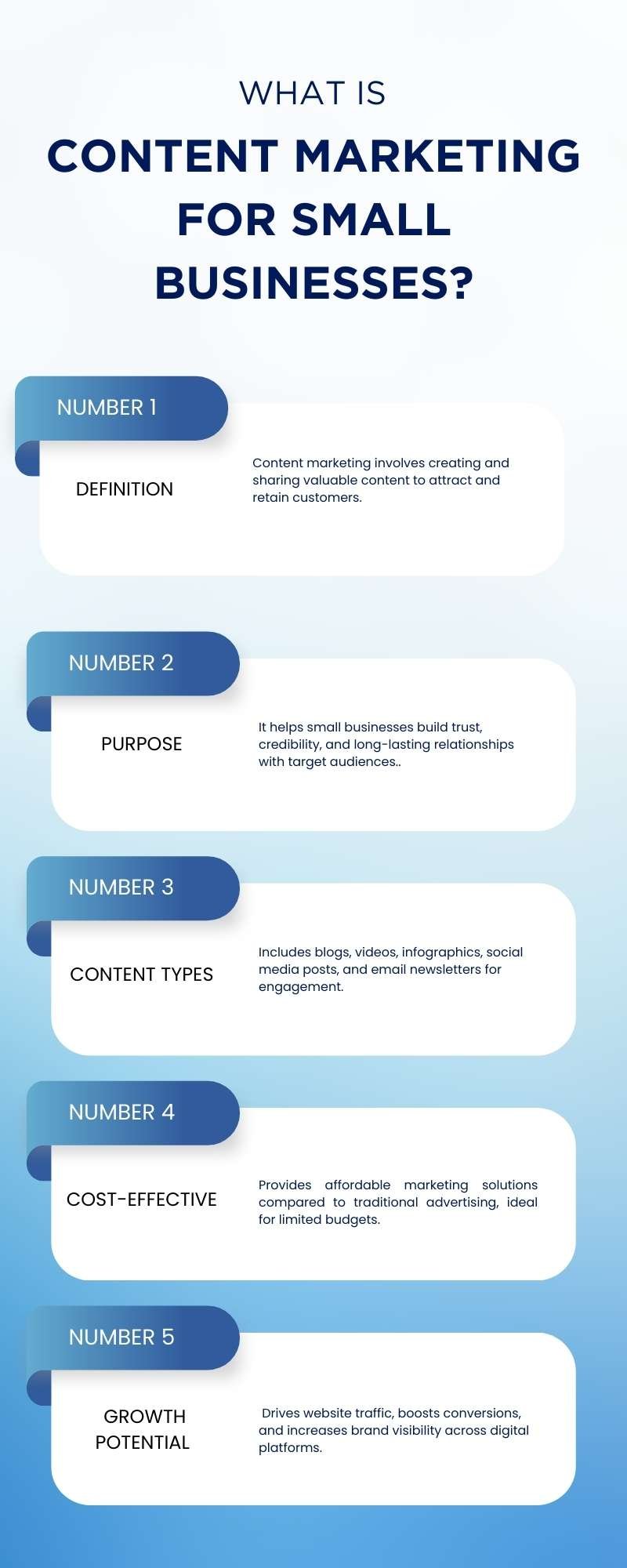
Content Marketing for Small Businesses: A Comprehensive Guide
Small businesses often struggle with marketing because they’re short on time, money, and resources. Competing with big brands that have massive budgets can feel overwhelming, and many owners aren’t sure which channels actually deliver results.
At its core, content marketing is about creating valuable and relevant content, such as blogs, videos, social posts, or even simple infographics, that attract and build trust with your audience. Instead of relying solely on ads, it focuses on long-term connections and credibility. Done right, it helps even the smallest businesses stand out in crowded markets.
This article, Content Marketing for Small Businesses: A Comprehensive Guide, will walk you through everything you need to know in 2025. You’ll learn why storytelling beats sales pitches, which formats work best on tight budgets, and how to build a strategy that keeps customers coming back. Whether you’re a local café, an online retailer, or a service provider, this guide will show you how to turn content into your most powerful growth tool.
What is Content Marketing for Small Businesses?
Content marketing for small businesses starts with creating valuable, engaging content that connects with local customers. Unlike big brands with massive budgets, small businesses need creativity and a personal touch to stand out. It’s about building trust and showing authenticity rather than chasing scale. For example, a local bakery can post Instagram reels of fresh bread coming out of the oven or behind-the-scenes baking moments. These simple, relatable stories attract nearby customers, spark conversations, and drive foot traffic. Content marketing for small businesses: A comprehensive guide is about turning everyday moments into meaningful connections.
Benefits of Content Marketing for Small Businesses
Content marketing is one of the most innovative ways for small businesses to grow without stretching their budgets. Instead of relying only on ads, businesses can create content that attracts, educates, and builds loyalty. Let’s break down the key benefits:
- Trust and Authority: When customers find helpful blogs, videos, or guides from your business, they see you as an expert. For example, HubSpot grew from a small startup to a global name by consistently publishing educational content.
- Lead Generation: Quality content pulls people in. A bakery posting Instagram reels of recipes can attract followers who later become paying customers.
- Budget Efficiency: Unlike paid ads that stop working once you stop spending, content stays online, working for you long-term. A single blog can bring traffic for years.
- Higher ROI: Every piece of content is an investment. With the right strategy, the cost per lead from content is often much lower than traditional advertising.
Real-world proof is everywhere. That piece of content didn’t just generate buzz; it turned into millions of customers and a billion-dollar acquisition.
Content marketing for small businesses: A comprehensive guide is not just about writing posts. It’s about creating a system that builds visibility, engages audiences, and drives sales over time.
Key Takeaway
Content marketing gives small businesses a cost-effective way to build trust, generate leads, and achieve long-term ROI all while competing with bigger players on an equal stage.
The Customer Journey and Role of Content
Every customer moves through three clear stages: awareness, consideration, and decision. At each step, content acts as a guide, shaping perception, answering doubts, and inspiring action.
- Awareness: This is the stage when people learn aware your brand. This is an excellent spot for blog posts, social media posts, and video tutorials. The goal is to grab attention and provide value without pushing for a sale.
- Consideration: Now the audience compares options. Case studies, whitepapers, and detailed guides help them weigh your brand against competitors.
- Decision: This is the final step, where trust is everything. Customer testimonials, free trials, and product demos reduce hesitation and drive conversion.
Here’s a simple map:
| Stage | Best Content Types |
| Awareness | Blog posts, social media, infographics, videos |
| Consideration | Case studies, eBooks, webinars, comparison guides |
| Decision | Testimonials, product demos, free trials, offers |
For small businesses, aligning content with this journey is a cost-effective way to win customers. As explored in Content Marketing for Small Businesses, focusing on the right content at the right stage not only builds credibility but also turns interest into loyal relationships.
Key Elements of a Successful Content Marketing Strategy
Every strong content plan starts with clarity. To make content marketing for small businesses: A comprehensive guide truly useful, you need to break the process into key elements that drive impact. Each step helps ensure your content connects with the right people, delivers measurable results, and scales over time.
One of the first steps in any content marketing strategy for small businesses is defining audience personas. Knowing who you’re speaking to shapes everything, tone, format, and even the platforms you choose. From there, clear goals and KPIs keep you focused. Aligning content with measurable outcomes helps you track progress and optimize as you grow.
Finally, no strategy works without smart distribution. SEO ensures your content gets discovered, while sharing across social channels, email, and partnerships amplifies reach. Consistency and adaptability matter just as much as creativity.
Key elements of a successful content marketing strategy include:
- Audience Personas: Define target groups based on needs, habits, and challenges.
- Goals & KPIs: Set clear metrics like traffic growth, lead conversions, or engagement rates.
- Content Planning: Map topics, formats, and publishing schedules for consistency.
- SEO Optimization: Research keywords, optimize pages, and build authority through backlinks.
- Distribution Channels: Share across social platforms, newsletters, and partner networks.
- Performance Tracking: Use analytics to refine content and scale what works best.
Best Types of Content for Small Businesses in 2025
In 2025, small businesses no longer compete only on price or product. They compete on how well they tell their story. The right content mix helps a local bakery, a growing SaaS startup, or even a home décor shop stand out in crowded markets. This section from Content Marketing for Small Businesses: A comprehensive guide explores the formats that bring the best results.
Blogs and SEO Articles
Blogs remain the foundation of digital presence. They help a business rank on search engines, answer customer questions, and build authority. A plumbing company writing “5 Signs You Need Emergency Repair” doesn’t just share tips—it attracts customers searching for solutions in real time. When optimized well, SEO articles continue to generate leads long after publishing.
Video and Short-Form Content
Consumers scroll fast, and video captures attention instantly. Short clips on Instagram Reels, TikTok, or YouTube Shorts showcase products, demonstrate usage, or tell behind-the-scenes stories. For example, a coffee shop sharing a 30-second video of latte art can spark local buzz and create shareable content that drives walk-ins.
Email Campaigns
One of the greatest yields for investment remains offered by email marketing. A curated weekly email with product highlights, seasonal offers, or personalized recommendations keeps customers engaged. Small businesses can use automation tools to send reminders, birthday discounts, or loyalty rewards, turning one-time buyers into repeat customers.
Case Studies and Testimonials
Trust is currency in 2025. Potential buyers want proof before committing. Case studies highlight real customer success stories, while testimonials add credibility. A digital agency sharing how it helped a client double sales builds confidence among prospects who want similar results. These assets often seal the deal when customers are comparing options.
Table: Content Types for Small Businesses
| Content Type | Best For | Example Use Case |
| Blogs & SEO Articles | Search visibility, education | Local gym writing “10 Home Workouts That Work” |
| Video & Short-Form Content | Engagement, brand awareness | Boutique posting outfit-of-the-day reels |
| Email Campaigns | Customer retention, repeat purchases | Restaurant sending weekly menu updates |
| Case Studies & Testimonials | Building trust, closing sales | IT firm showcasing a client’s growth story |
7 Actionable Content Marketing Ideas for Small Businesses
- Create Educational Blogs: Sharing practical tips through blogs positions your business as a trusted voice. For example, a bakery can post “5 Quick Breakfast Recipes” featuring its bread. Blogs drive organic traffic, answer customer questions, and strengthen brand credibility over time—an essential element in content marketing for small businesses.
- Optimize for Local SEO: Most small businesses thrive on nearby customers. Publishing location-based content helps capture local searches. A salon could write about “Top Hair Trends in Delhi 2025” and optimize with city keywords. Adding Google Business posts, customer reviews, and geo-tags further ensures your content connects with people in your neighborhood.
- Produce Short Video Demos: Videos explain complex products in seconds. A fitness studio can post quick demo clips of a new workout, showing real trainers in action. These bite-sized videos are perfect for Instagram Reels or YouTube Shorts, where engagement is high. Visual proof builds trust and nudges prospects toward trying your services.
- Highlight Customer Stories: Turning happy customers into stories creates powerful marketing. A café might share a regular visitor’s journey from working remotely at their tables to hosting community events there. Adding photos or short clips makes the story relatable. People trust real experiences more than ads, which makes these stories resonate deeply.
- Email Drip Campaigns: Email is still a cost-effective channel. Instead of generic blasts, create drip sequences. For example, an online clothing store can send a welcome email, followed by style tips, and then exclusive discount codes. This sequence nurtures leads step by step, improving conversion rates while building long-term customer loyalty.
- Launch Seasonal Campaigns: Festivals, holidays, and local events provide endless content opportunities. A flower shop can run Valentine’s specials with themed blog posts, reels, and email promotions. Aligning offers with cultural or seasonal moments grabs attention when buyers are most willing to spend. Timely campaigns make your content relevant and memorable.
- Collaborate with Micro-Influencers: Influencer partnerships don’t have to be costly. For example, a bookstore could partner with a local book reviewer to showcase new arrivals. These collaborations amplify reach while keeping campaigns affordable, making them ideal in content marketing for small businesses: A comprehensive guide.
How to Build a Content Marketing Plan Step by Step?
Creating a structured content marketing plan helps small businesses stay consistent, reach the right audience, and maximize impact. Here’s a simple breakdown of the process:
Step 1: Research
Start with your audience. Identify who it is, what problems they face, and where they consume content. Use tools like Google Trends or social media insights to understand what topics resonate. Competitor analysis also helps you spot content gaps and opportunities.
Step 2: Content Calendar
Once you know your audience’s needs, planned your content. A content calendar keeps you organized by mapping topics, formats, and publishing dates. For example, schedule blog posts on Mondays, reels or shorts on Wednesdays, and carousels on Fridays. This structure ensures consistency and reduces last-minute stress.
Step 3: SEO Optimization
Good content alone is not enough. You need visibility. Optimize every piece for search engines by using relevant keywords, adding engaging titles, and writing meta descriptions. For blogs, make use of headings and internal links. It increases the chances of ranking higher and bringing in organic traffic.
Step 4: Repurpose Content
Don’t let a single idea live only once. Turn a blog post into a LinkedIn carousel, an infographic, or even a short video. Repurposing extends the lifespan of your content, helps you reach audiences on different platforms, and saves time in the long run.
Tools Small Businesses Can Use for Content Marketing
Choosing the right tools makes content creation easier and more effective. In this content marketing for small businesses: A comprehensive guide, here are some practical options:
- Ubersuggest and Google Keyword Planner for free SEO research.
- Buffer and Hootsuite to schedule posts and manage multiple social accounts.
- ChatGPT for quick content ideas and drafts.
- Canva for simple, professional design work.
Measuring Success: Metrics Every Small Business Should Track
Every small business owner knows that effort alone doesn’t guarantee growth. What really matters is measuring the impact of your marketing activities. Without the right metrics, it’s easy to waste time and budget on strategies that don’t deliver results. The good news? You don’t need to track everything, just the essentials that directly show how well your marketing engine is working.
Start with traffic, the lifeblood of any online business. It tells you whether your campaigns and content are bringing in visitors. Next, focus on leads. Traffic means little if those visitors don’t engage or show interest in your product. From there, look at conversions, the moments when leads take meaningful actions, such as signing up or purchasing. Finally, keep an eye on ROI (Return on Investment). It connects the dots between money spent and revenue earned, ensuring your strategy is sustainable.
By consistently reviewing these numbers, you can see what’s working, cut what isn’t, and refine your approach. It makes your marketing more innovative and more profitable. If you’re applying insights from Content Marketing for Small Businesses: A comprehensive guide, these four metrics will give you a clear, data-driven path to growth.
| Metric | Why it matters | Tool to track |
| Traffic | Shows if people are finding your business online | Google Analytics |
| Leads | Measures audience interest and engagement | HubSpot, Mailchimp |
| Conversions | Tracks sales or key actions taken | Google Ads, Shopify |
| ROI | Proves if campaigns deliver real financial returns | Excel, SEMrush, Zoho |
Future Trends in Content Marketing for Small Businesses
The digital space is changing fast, and small businesses need to keep pace. Staying ahead means understanding where content is headed and how to use it smartly. Here are the key trends shaping the future:
- AI-driven content creation: Tools powered by artificial intelligence can speed up research, idea generation, and even draft creation. It gives small teams the power to compete with bigger players by saving time and scaling output without losing quality.
- Voice search optimization: As smart speakers and voice assistants grow, more people search conversationally. Content must adapt with natural phrases, question-based formats, and quick, clear answers that align with spoken queries.
- Hyperlocal content: Small businesses thrive when they connect with their immediate community. Creating content tailored to local events, culture, and needs builds trust and drives foot traffic, both online and offline.
Adopting these trends ensures lasting visibility. For those exploring content marketing for small businesses: A comprehensive guide, the message is apparent: success lies in being adaptable, tech-aware, and deeply connected to your audience.
Conclusion: Building a Sustainable Content Marketing Engine
Content marketing works best when treated as a long-term investment, not a quick win. It helps small businesses build trust, improve visibility, and attract customers without burning through ad budgets. The real strength lies in consistently publishing valuable content week after week, creating momentum that compounds over time. From blog posts and reels to newsletters, every piece adds to your brand voice and credibility. As highlighted in Content Marketing for Small Businesses, the growth path is clear: plan brilliantly, stay consistent, and refine along the way. Start applying these strategies today to turn content into a steady driver of leads and customer loyalty.







Add Comment